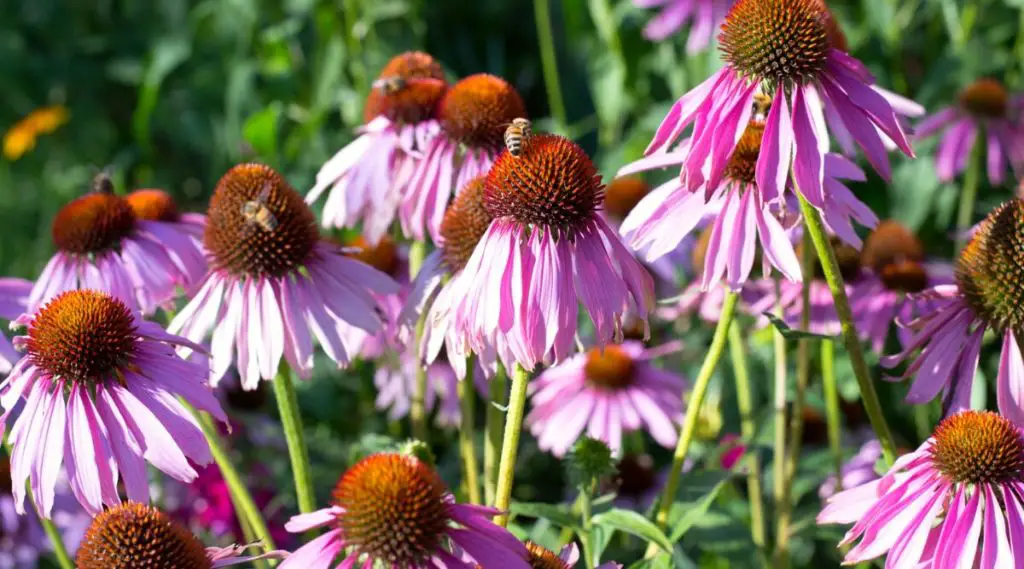Coneflowers (Echinacea purpurea) are popular perennial flowers that thrive in full sun and well-drained soil. They are low maintenance, drought and heat tolerant, and hardy to most growing zones. Coneflowers are best transplanted when they are dormant, either in early spring before growth starts or in fall after flowering ends. Fall is an excellent time for transplanting coneflowers. Here is a detailed guide on successfully transplanting coneflowers in the fall.
Page Contents
When is the best time to transplant coneflowers in fall?
Coneflowers can be safely transplanted in fall once they have gone dormant. The ideal window is around mid-September through late October. Here are some tips for optimal fall coneflower transplanting:
- Wait until several weeks after coneflowers have finished blooming. This allows the plants to direct energy to root growth rather than flowers.
- Transplant before the ground freezes. Coneflowers need 4-6 weeks for roots to establish before winter dormancy.
- Ideally transplant 6-8 weeks before first expected fall frost. This gives sufficient time for rooting before winter.
- Transplant when daytime temperatures are consistently below 75°F. Cooler fall temperatures help reduce transplant stress.
Mid-September to mid-October is the prime time for fall coneflower transplanting in most regions. Adjust timing depending on your local fall climate.
Where to transplant coneflowers in fall
Coneflowers grow best in these conditions:
- Full sun – at least 6 hours of direct sunlight daily.
- Well-drained soil – avoid soggy, compacted soils.
- Neutral pH – ideal range is 6.0 to 7.5.
- Average fertility – avoid very rich or poor soils.
- Sheltered spot – protected from strong winds.
When choosing where to transplant coneflowers, pick a spot in your garden that meets these criteria. Some ideal locations include:
- Flower beds – mix with other sunny perennials and annuals.
- Borders – line walkways, fences or edges of yard.
- Cottage gardens – scatter among other informal, flowering plants.
- Cutting gardens – grow for cutflowers.
- Wildlife gardens – attract pollinators like bees and butterflies.
- Naturalized areas – allow to spread freely in sunny meadows.
How to prepare for fall coneflower transplanting
Proper planning and preparation ensures success when transplanting coneflowers in fall. Here are some tips:
- Check soil drainage – Dig a 12″ deep hole where you intend to transplant. Fill with water. If water doesn’t drain in 8-12 hours, improve drainage before planting.
- Improve poor soils – Amend with compost or topsoil if needed to improve fertility, drainage and structure.
- Eliminate weeds – Remove invasive weeds which may outcompete establishing coneflowers.
- Water thoroughly – Deeply soak the soil before and after transplanting to encourage rooting.
- Harvest seeds – Collect and store seeds if desired from existing plants before transplanting.
Taking time to prepare the transplant site properly will give your coneflowers the best chance of thriving in their new fall location.
How to transplant coneflowers in fall:
Follow these steps for successfully transplanting coneflowers in the fall:
- Water coneflowers thoroughly 1-2 days before digging them up.
- Prepare new planting hole at least twice as wide and deep as the root ball.
- Carefully dig up the coneflower using a spade or garden fork, keeping the root ball intact.
- Gently loosen any circled roots to encourage outward growth.
- Place coneflower in hole so top of root ball is level with ground.
- Backfill hole with native soil, pressing firmly around roots to eliminate air pockets.
- Create shallow watering well around plant to help direct water to roots.
- Water transplanted coneflower thoroughly until soil is saturated.
- Apply 2-4″ organic mulch around plant to conserve moisture and reduce weeds.
- Water regularly until ground freezes. Avoid fertilizing late in fall.
Properly following these transplanting guidelines will give your coneflowers the best chance of flourishing in their new location.
Aftercare when transplanting coneflowers in fall
Attentive aftercare improves success rates when transplanting perennials like coneflowers in fall. Here are some tips for best results:
- Water thoroughly – Continue deep watering every 4-5 days until ground freezes.
- Weed vigilantly – Remove competing weeds, being careful not to damage establishing roots.
- Monitor for pests – Watch for slugs, snails and other pests that may attack stressed transplants.
- Avoid fertilizing – Don’t add high nitrogen fertilizer late in fall to prevent frost tender growth.
- Leave seedheads – Allow spent flowerheads to remain for winter interest and bird food source.
- Mulch heavily – Apply 4-6″ of organic mulch over plants in late fall for insulation.
- Cut back in spring – Old flower stems can be trimmed back once new growth resumes next year.
Attentive fall care will help newly transplanted coneflowers settle in well before going dormant for winter.
What to expect after transplanting coneflowers
Here’s what to expect with your transplanted coneflowers through their first year post-transplant:
- 1-4 weeks after transplant – Water frequently to encourage root establishment. Some foliar dieback is normal as plants adjust.
- Fall – Flowering likely won’t recur in the first fall after being moved. Plants focus energy on root growth instead.
- Winter – Mulch over dormant plants for insulation after the ground freezes.
- Spring – Remove dead growth in early spring. Flowering may be reduced in year one after transplanting.
- Second summer – Transplanted coneflowers resume normal flowering and establish fully by second year.
Have patience with transplanted coneflowers – their root system needs time to reestablish before they’ll thrive. But with proper aftercare, they should flourish beautifully in their new location.
Conclusion
Fall is an optimal time to transplant coneflowers. By selecting healthy plants, preparing the site, transplanting carefully, and providing attentive aftercare, you can successfully move coneflowers in autumn with great results. Transplanted coneflowers may take a full year to resume flowering and reach their full potential in their new location. But with proper care, fall transplanted coneflowers can thrive for many years to come.
